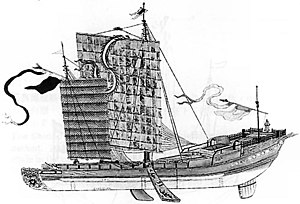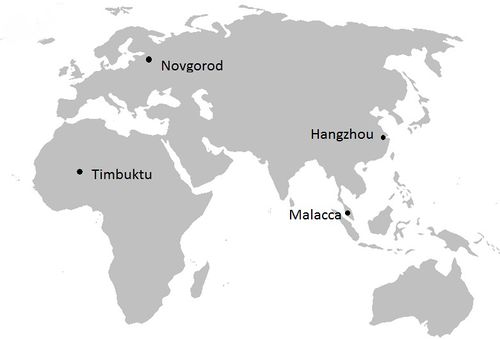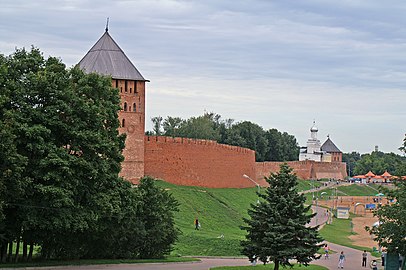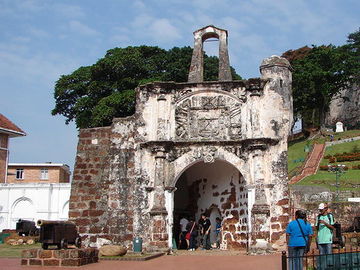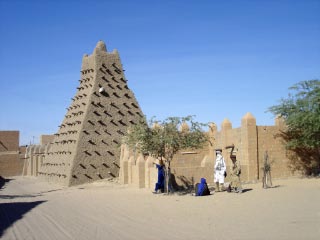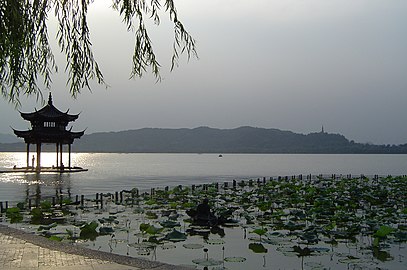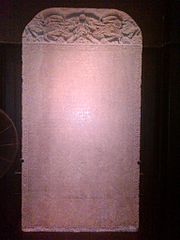Topic 2.3 Exchange in the Indian Ocean
The Indian Ocean was the dominate network of trade in the era 1200 to 1450. In terms of the volume of trade, the number of people involved, and the interaction of various cultures, the Indian Ocean network was unrivaled in this period. It did, however, bears some continuities with the pre-1200 era. For example, it remained closely tied to environmental conditions, namely the monsoon winds that merchants had to consider while scheduling their departures. This meant that the port cities along the rim of the Indian Ocean at any given time had large numbers of non-citizens waiting for changes in the monsoon winds. Thus these cities were cosmopolitan and exuded a great deal of cultural tolerance. Because this is a maritime network, Indian Ocean trade continued to be the ideal network for exchanging bulk items, such as timber, ivory, spices, cotton textiles, and other things that would be difficult to move on land routes. Finally, Indian Ocean trade continued to be free from the domination of any state or empire. The seas were open to all merchants and not until the arrival of the Europeans would any single power attempt hegemony.
Indian Ocean trade experienced major changes in this time. The volume of exchange increased dramatically and the number of civilizations participating increased. The Abbasids and other subsequent played a significant role in the increase of trade in the Indian Ocean. We have seen already how the civilization of Islam encourages trade, and the Muslim city-states along the Swahili coast of east Africa contributed enormously to maritime trade. Gold, ivory, and exotic animals made their way from sub-Saharan and southern Africa to these cities, through which they entered the busy sea routes of the Indian Ocean. Islam followed the path of goods, making converts across the network, particularly southeast Asia. On the Malay peninsula in southeast Asia, the Buddhist kingdom of Srivijaya thrived on the lucrative spice trade that flowed through the straits of Malacca. Srivijaya became an important kingdom for the diffusion of Buddhism across the region. Another political development that increased Indian Ocean trade was the recovery and economic flourishing of China. During the Song Dynasty, Chinese maritime trade exceeded Silk Road trade, and Chinese porcelain has been found as far away as the Swahili coast of Africa.[1] The efficiency and volume of trade in the Indian Ocean was also facilitated by the introduction of new maritime technologies. The Chinese introduced the compass and massive trading ships called Junks which were able to carry larger cargoes. The Arabs popularized the Dhow ship which was able to tack against the wind because of its advanced lateen sail. Finally, an instrument called the astrolabe allowed skilled sailors to determine their latitude at sea. All of these advancements increased participation, facilitated navigation, and removed some of the risks of maritime trade.
The expansion and intensification of trade networks in this era led to the rise of new cities as major trade hubs. Cities became the collection points where craft items were massed for bulk sale, the crossroads of major trade routes, and the ports connecting zones of trade together. Some important examples are:
- As a member of the Hanseatic League, the northern Russian city of Novgorod was vital in connecting European merchants with their Arab and Byzantine counterparts. Its surrounding marshes and thick forests protected it from the Mongol conquests allowing its importance for the coveted trade in fine furs to be uninterrupted.
- In southeast Asia Malacca became an important city in the spice trade. It was a collection point for spices grown on tiny islands across Indonesia. In Malacca they were packaged and sold in bulk on the Indian Ocean. The city's location on the straits of Malacca allowed it to collect tolls and control passage.
- The location of Timbuktu on the southern rim of the Sahara Desert raised its importance for trans-Saharan caravan trade. It became an exchange point for west African gold and north African salt. Because of the trade in books, the city also became an important city for Islamic scholarship and education.
- Hangzhou was located near China's southern coast and on the Grand Canal which connected it across 1000 kilometers to Beijing. It was a departure point for Chinese goods to Korea, Japan, southeast Asia, and the Indian Ocean trade network. It became the capital of China during the Southern Song Dynasty.
- SWAHILI COAST CITY-STATES
- Trade is directly responsible for the rise of states in this time. On the eastern coast of Africa, trade and Islam gave rise to powerful but independent city-states that thrived on Indian Ocean commerce. Something of this region's history can be seen from its name: Swahili is a language that formed through the blending of Bantu and Arabic. These African city-states were profoundly affected by Arab merchants who brought Islam to east Africa thus pulling them into the activity of Indian Ocean trade.
- Sustained contact with Muslim merchants of Arabia kept the practice of Islam in these city-states relatively pure. This is in contrast to the syncretic practices found inland, which looked more like African traditional beliefs the farther one moved inland from the eastern coast. Despite the strong Islamic character of the Swahili city-states, they were highly tolerant and cosmopolitan. Because of the seasonal monsoons, at any given time these cities were occupied by many merchants of many faiths waiting for the winds to favor their departure. Thus Christian, Hindu, Confucian, Jewish and Buddhist merchants were in these cities at the same time. Tolerance was good for business.
- The Swahili city-states were important points for connecting inland trade into the vast Indian Ocean network. Especially important was the city of Kilwa, which was the farthest down the coast a merchant ship could sail in a typical monsoon season. For this reason it attracted trade from the southernmost part of Africa. With this outlet for gold and ivory, the powerful Great Zimbabwe formed in southern Africa. Great Zimbabwe stands as a good example of an African state that developed along Bantu lines; it was out of the reach of Islam's influence, unlike Ghana, Mali and Songhai to the north.
- SWAHILI COAST CITY-STATES
- The rise of diasporic merchant communities was both a product of exchanges and a means of facilitating trade. The word “diaspora” comes from the Greek, meaning “to disperse.” Merchant diasporas were communities of people from a common culture living together outside their native homeland. They formed in ports, cities, and other important locations along major trade routes. Examples are communities of Jews living in Muslim Cairo, or an enclave of Muslim merchants living in Calicut on the coast of South Asia. The travel journals of Ibn Battuta and Marco Polo both mention the presence of Jewish merchant communities in China. [2] Diasporic communities provided convenient links to traveling merchants visiting foreign lands. For example, a merchant from South Asia traveling help bridge the cultural differences between the merchant and the host culture in which he was conducting business. "In an era when contracts could be hard to enforce, especially across political boundaries, it helped to deal with people who came from the same place you did." [3]
- It was inevitable that culture from diasporic merchant enclaves would migrate into the host societies. When a Chinese merchant community settled in Nagasaki Japan, they recruited Buddhist monks from their homeland to join them. Buddhist rites were valued for trade and monks ensured a cultural consistency with the merchants' homeland. Next came the building of Buddhist monasteries and graveyards. Consequently, the growth of Chinese strands of Buddhism in Japan would have a long term impact on Japan. [4]
- It was inevitable that culture from diasporic merchant enclaves would migrate into the host societies. When a Chinese merchant community settled in Nagasaki Japan, they recruited Buddhist monks from their homeland to join them. Buddhist rites were valued for trade and monks ensured a cultural consistency with the merchants' homeland. Next came the building of Buddhist monasteries and graveyards. Consequently, the growth of Chinese strands of Buddhism in Japan would have a long term impact on Japan. [4]
- Zheng He
- The most extravagant maritime outreach early in this period was that of the Chinese. After the peasant revolt that threw out the Mongols and established the Ming Dynasty, the Chinese commissioned 7 major voyages under the leadership of admiral Zheng He. With an estimated 317 ships and a staff of 27,000 men, [5] Zheng He set out to establish the reputation of the Ming in the Indian Ocean. He sailed initially to southeast Asia and India but his final three voyages reached as far as the Swahili coast of east Africa. Unlike the European voyages that began a few decades later, these Chinese expeditions were not driven by attempts to conquer or win converts. They were diplomatic in nature, intended to impress upon others the prestige, wealth and superiority of Chinese civilization. Once other societies saw this, they would be willing to pay tribute to China for the right to purchase costly Chinese luxury products such as silk and porcelain. On his two year voyage of 1431-1433 alone, Zheng He established for China 20 tributary and diplomatic relations across the rim of the Indian Ocean. [6]
- The Chinese strategy in the Indian Ocean could not have been farther from that of the Portuguese a few decades later. In 1911 a stele, shown on the left, was discovered in Galle, south of India (present day Sri Lanka). It is inscribed not only in Chinese, but in Tamil and Persian, the primary languages of the inhabitants of that area. This stele was placed by Zheng He in 1409 as a gift to the people of Galle; its inscriptions list the extravagant gifts made by Zheng He in honor of the inhabitants' gods, in their own languages, to demonstrate China's good will. This is to be contrasted with Vasco da Gama, who cut apart the bodies of captured merchants and fishermen and sent their heads to the leader of Calcutta to show he meant business. [7]
- Unfortunately for Zheng He, a change of power in imperial China brought these voyages to an end. A new emperor, under the influence of powerful Confucians long suspicious of these voyages, withdrew funds for these diplomatic missions. The official records of Zheng's voyages were destroyed and the large treasure ships of the Chinese were banned. China began to focus instead on establishing internal stability over reaching out to the world.
- ↑ The Song Dynasty in China. , Columbia University, Asia For Educators.(http://afe.easia.columbia.edu/song/out/trade.htm) .
- ↑ "Encyclopedia of Diasporas: Immigrant and Refugee Cultures Around the World. Volume I: Overviews and Topics; Volume II: Diaspora Communities, (2004), Melvin Ember, Carol R. Ember, Ian Skoggard, p. 153.
- ↑ "The World that Trade Created: Society, Culture, and the World Economy: 1400 to the Present, (2006), Kenneth Pomeranz and Steven Topik, p. 7.
- ↑ "Secondary Cities and Urban Networking in the Indian Ocean Realm, C. 1400-1800, (2008), Kenneth R. Hall (ed.), p. 208.
- ↑ China: A New History. (2006) John K. Fairbank and Merle Goldman, p.138.
- ↑ The Discoverers. Boorstin, p.191.
- ↑ The Discoverers, Boorstin, pp.193-194.

